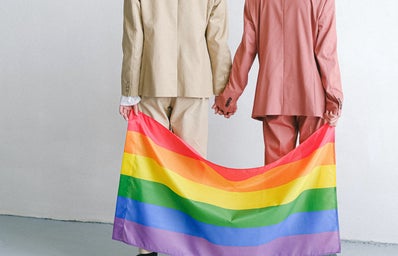”Drag is for everyone, and I’m here to show you how!”
Victoria Scone
This is one for the Her-Story Books: this article will shed light on the importance of Victoria Scone’s appearance on RuPaul’s Drag Race UK
The glitzy, glamorous and enormously camp “Rupaul’s Drag Race” has never been a TV show that has accepted the norm, nor fit the mould of the more mundane and conventional programmes that praise format and sameness. Starring famous drag queen RuPaul Charles as its host, this show aims to find the “Next Drag Superstar”, by pitting drag queens against each other in various intricate challenges of design and drive.
Recently, conversations of who should be allowed to enter Drag Race have been sparked, thanks to the ‘her-story’ making the appearance of cisgender lesbian woman “Victoria Scone”, who has joined the UK season three line-up of drag queens. Victoria is the first female queen to appear on the show, urging the audience to open their minds to different kinds of drag queens, abolishing the idea that there is only one “correct” way to do drag.
Who is Victoria Scone?
Upon her first entrance into the ‘Werkroom’, we knew Victoria’s presence would not be ignored. Arriving in a gorgeous, floor-length red robe, Scarlett Harlett, Victoria’s fellow contestant, said it best; “THIS IS A GAG!”
Originating from Cardiff, Victoria is a professionally trained triple threat, boasting talents in singing, acting, and dancing (made all the more impressive by that she performs in six-inch heels and a breathtakingly tight corset). She describes her style as “very, very camp”, claiming she was “born to be a drag queen”. It’s clear that Scone is fulfilling her self-prophesied identity, with 146,000 Instagram followers and plans for extravagant shows across the UK.
Though Victoria is making history with her appearance, she is certainly not the first queen to shatter gender barriers on the show. Transgender, female drag queen Kylie Sonique Love stole both our hearts and the crown as she won Drag Race All Stars Six (if you’ve seen it, you’ll know she was the clear winner, obviously), becoming the first trans queen to win a season of Drag Race. Additionally, Drag Race has starred many iconic nonbinary queens, such as Ginny Lemon (UK S2) and Gigi Goode (US S12).
Along with an impressive drag reputation, Victoria has an abundance of drive and passion for her art, which are the necessary traits for a woman in the cutthroat world of drag, a culture that claims to be inclusive, but often refuses entry to anyone who isn’t a cisgender homosexual male. In spite of its surface-level messages of pride and inclusion, the rainbow slogans of the LGBTQ+ community often conceal and camouflage a deep-rooted misogyny that attacks and excludes lesbians, trans women, and anyone on the spectrum of female identity. As a consequence of this, despite Victoria’s flawless drag, when news of a cisgender woman starring in RuPaul’s Drag Race season three broke, misogynistic trolls angrily that flocked to their keyboards to make sure that their voices were heard loud and clear.
In a now-deleted and heavily criticised YouTube video titled “Why I don’t support Victoria Scone on RuPaul’s Drag Race”, Daniel Perez delivered what was possibly the worst take of the year, claiming Victoria is “taking a spot away from a guy that doesn’t get opportunities” and that her casting marks the downfall of Drag Race. Luckily, not many people were manipulated by the sexist rants of Perez, giving me hope that there are still sane and intelligent people on the internet.
Sadly, Victoria has been conditioned to expect backlash towards her drag, as in an interview with BBC Three, she revealed that during her first drag competition, she was told “this isn’t the competition for you”. Such ignorant comments can be expected towards most queens who don’t fit the idea of “classic drag” (a cisgender queer man). In season one of RuPaul’s Drag Race Down Under, non-binary queen Etcetera Etcetera noted how people seem to get confused that they do not present as a man outside of drag. In regards to gender, Etcetera states that “people like to think of things as black and white but there’s so much grey”.
So what does all this representation mean for the future of drag?
Victoria has expressed hope that her appearance on Drag Race UK can “can help boost diversity in the drag world,” stating that there is “no more excuse for event organisers to not be booking more diverse lineups”. Victoria’s appearance on the show will hopefully make way for female-identifying/“non-traditional” drag queens to be taken more seriously in drag culture.
However, though this may all seem like an inarguably positive change, scepticism is rife on the authenticity of the recent floods of representation within Drag Race. Host RuPaul has invalidated the drag of both women and nonbinary people, by stating “Drag loses its sense of danger and its sense of irony once it’s not men doing it”. This has led both the audience and queens alike to believe that Rupaul’s inclusion of different types of queens in new seasons is simply for publicity and image fixing, with the non-binary, ex-contestant Ginny Lemon (UK S2), accusing the show of using them “for a nice little non-binary storyline”.
Nevertheless, whilst the behind-the-scenes intentions behind their appearance on the show are questionable, Victoria Scone and all the barrier-bashing non-binary and transgender queens that have appeared on Drag Race mark an important point in drag and LGBTQ+ history. They are important figures that display evidence of the gradually accommodating modernisation of drag, and so make a promise that the art form is for anyone who wants to take part. For some, seeing this representation in mainstream media can be the push that it takes for them to accept their own identity.
Victoria Scone is a woman who has taught us that we can present and perform in any way we please, regardless of our gender or sexual identity. It’s a pleasure to have you on our telly screens Victoria!
Some “non-conventional” and underrated drag queens you can support:
- Lilly SnatchDragon is a South-East Asian cisgender woman drag queen/burlesque star (@lillysnatch on Instagram).
- Venus Dimilo is a Cisgender woman drag queen, known for proudly displaying their disability to shatter notions of what a drag queen “should” look like (@venus_dimilo on Instagram).
- Pangaea is non-binary queen who appeared in paper magazine’s article on the costume of Chicago nightlife (@pangaeas_planet on Instagram).
- Lucy Stoole is non-binary, bearded queen with a “unique brand of gender fuckery” (@tyislucystoole on Instagram).
Words by: Daisy Thorogood
Edited by: Olivia Davies


